
Celebrate ten years of Urban Omnibus and support ten more years of fresh, independent perspectives on citymaking with a donation today!
Celebrate ten years of Urban Omnibus and support ten more years of fresh, independent perspectives on citymaking with a donation today!
Affordable housing is on New York City’s mind. A critical mass of civic organizations, academic institutions, city agencies, advocacy groups, and others are pondering the essential and perennial issue of how to ensure that the city becomes affordable for the extraordinarily diverse population that makes it work. What’s more, the conversation is riding a new wave of perceived political support from the de Blasio administration, which has tapped leading academics and esteemed private and public sector figures to deliver on its ambitious promise to build or preserve 200,000 units of affordable housing in ten years. With the details of the Mayor’s plan due to be released May 1st, we will undoubtedly be hearing a great deal of commentary about policy and implementation — development sites, low-income housing tax credits, preservation, NYCHA reforms — for weeks to come.
At the same time, a decades-old strategy to maintain housing affordability is finding a groundswell of support from an increasingly diverse group of stakeholders. A community land trust (CLT) is an alternative model that separates the ownership of property from the ownership of the land on which that property is built. In effect, organized citizens remove land from the private, speculative market where its value is difficult to control. Below, housing advocate Oksana Mironova charts the origins of this approach, explaining how it has become an appealing solution to problems affecting communities across the country. In so doing, Mironova touches on the current effort underway to bring a new CLT pilot project to East Harlem as well as the adaptations that would allow a traditionally hyper-local and community-driven project to scale up to the city-wide level. — G.S.
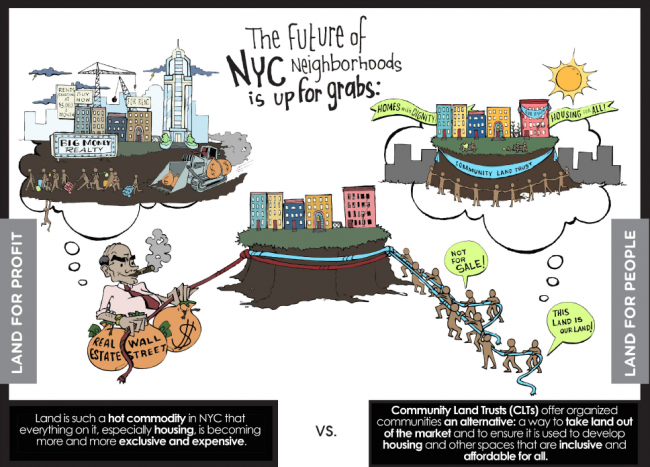
CLT promotional graphic by NYC Community Land Initiative
A combination of stagnating wages and rising rents has left more than half of New York City’s renters rent burdened. The scale of the city’s housing crisis is pushing advocates, policymakers, academics, and average New Yorkers to seek out new ways to build and preserve affordable housing. One model that is gaining traction among some of the city’s housing advocates is the community land trust (CLT). CLTs have a dual tenure structure, where the ownership of land and the ownership of property are separated. Urban CLTs frequently operate on a community-wide scale and seek to address broader issues beyond housing affordability, ranging from neighborhood stabilization to environmental sustainability. While New York City has a few existing CLTs, many challenges limit broader implementation, especially the high cost of land. The multi-faceted nature of the CLT model is nonetheless pertinent to the city’s housing crisis, a structural problem that cannot be addressed on the individual unit or building scale.
History and National Landscape
The CLT model is rooted in the 1960s civil rights movement. Activists established the first CLT — New Community Land Trust in Albany, GA — to provide land ownership opportunities to African-American farmers. The experiment eventually led to the founding of the Institute for Community Economics (ICE), which today is one of the key funders of CLTs across the US. In 2012, there were 258 CLTs, with 9,000 units of housing, distributed across 46 states. There is a smaller sub-group of CLTs that function in urban areas like New York City.
Many urban CLTs today have a broad mandate developed in response to specific neighborhood needs.The CLT model falls into the shared equity category of tenure, which operates in a zone between homeownership and renting. This category — which includes CLTs along with limited equity cooperatives, mutual housing associations, and deed-restricted housing — ensure property affordability through sale-restriction mechanisms. In New York City, City- and State-subsidized Mitchell-Lama limited equity cooperatives are the most prevalent form of shared equity housing. In Shared Equity Homeownership, John Davis defines CLTs as “a dual ownership model…where the owner of the land is a nonprofit, community-based corporation, committed to acquiring multiple parcels of land throughout a targeted geographic area with the intention of retaining ownership of these parcels forever.” Buildings on CLT land may include single-family homes, rental buildings, condos, co-ops, and mixed-use structures with commercial or office spaces. CLTs lease land to property owners through long-term ground leases, which typically run for 99 years. The sale of property on CLT land is governed by a resale formula outlined in the ground lease, which usually gives the CLT the first right of purchase. When the CLT resells the property, for a below-market price to a buyer who meets agreed-upon income-eligibility requirements, the deed to the building is conveyed to a new owner. The deed to the land remains with the CLT.
Like the first community land trust in Georgia, many urban CLTs today have a broad mandate developed in response to specific neighborhood needs. Larger, well-established CLTs function like community development corporations, with a range of programs and professional staff. For example, the Sawmill Community Land Trust grew out of a history of community organizing against a particleboard manufacturing plant in Albuquerque, according to Connie Chavez, Sawmill’s Executive Director. The polluted land was eventually acquired by the City for Superfund remediation. The Sawmill Environmental Council successfully petitioned the City to turn the land into a CLT.
The CLT model was chosen “to protect low-income residents from gentrification,” said Chavez, “and to enable them to make decisions about and benefit from the redevelopment of the area… Sawmill is adjacent to the downtown business district and the historic Old Town area, one of New Mexico’s biggest tourist attractions. The encroachment of these interests has caused real estate values in the surrounding neighborhoods to spiral upwards, pushing land and housing costs beyond the affordability of most families that have lived here for decades.” Today, the Sawmill CLT is remediating 27 acres of land into Arbolera de Vida, which includes housing, a park, a community center, offices, retail space, manufacturing, senior apartments, and live/work spaces for home businesses.
Historical Context for CLTs in NYC
The Cooper Square CLT and Rehabilitation in Action to Improve Neighborhoods (RAIN) CLT both emerged during a turning point on the Lower East Side, as extreme disinvestment and neighborhood abandonment in the 1970s gave way to aggressive real estate speculation in the 1980s. While many CLTs focus on producing new housing units, both New York City cases emerged out of broader community organizing efforts focused on preserving the affordability of existing units.
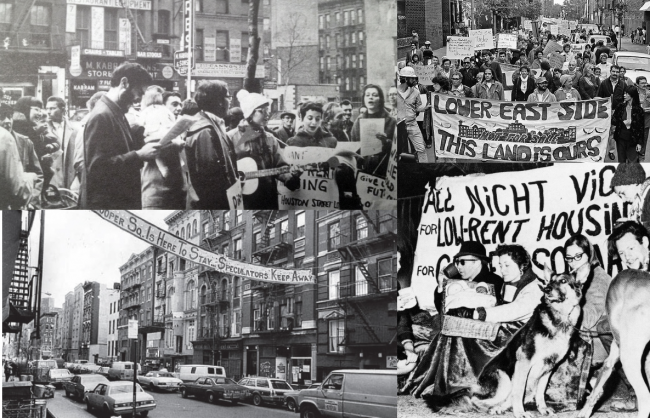
Cooper Square Actions | courtesy of the Cooper Square Committee
In an in-depth study of the Cooper Square CLT, Tom Angotti, Professor of Urban Affairs and Planning at Hunter College and Cooper Square CLT board member, explains its roots in a community organizing effort against a 1959 urban renewal project initiated by Robert Moses, which would have demolished 11 blocks on the Lower East Side between the Bowery and 2nd Avenue. Community opposition formalized into the Cooper Square Committee (CSC) and developed an alternative plan for the area in 1961.
The 50-year saga of the alternative plan’s implementation is described in It Took 50 Years: Frances Goldin and the Struggle for Cooper Sq. The unreleased documentary focuses on the plan’s evolution in response to neighborhood change and on Frances Goldin, one of the main driving forces behind its implementation. When the City finally accepted the alternative plan in the early 1970s, the Cooper Square Committee was “the first to confront the basic reality of retracting government” said Dave Powell, a housing activist and one of the film’s documentarians. In 1973, the federal government put a moratorium on any new federally subsidized housing programs, making a key feature of the alternative plan — the development of new permanently and deeply affordable housing — unachievable.
In the following years, the Cooper Square Committee shifted their focus to residential displacement due to fires and property neglect. By the late 1970s, the neighborhood was awash with tenant-occupied properties that were abandoned by their landlords and taken over by the City due to the non-payment of taxes. The Cooper Square Committee was aware of the Tenant Interim Lease (TIL) program that allowed tenants to turn their buildings into limited-equity cooperatives, according to Powell. However, the CSC also knew that affordability restrictions under the TIL program only lasted 15-20 years and realized that real estate speculation was beginning to put pressure on affordability restrictions in some newly formed cooperatives on the Lower East Side.
Therefore, the group settled on the CLT model after looking for “a limited-equity cooperative model that did not sacrifice permanent affordability,” said Powell. In 1991, the CSC created the Cooper Square CLT and the Cooper Square Mutual Housing Association (MHA), for 356 apartments in 22 formerly City-owned buildings. A few years ago, Cooper Square received State approval to turn the residential units into a limited-equity cooperative, which will remain a permanently affordable leaseholder of the Cooper Square CLT.
Cooper Square’s multi-layered governance structure — with two distinct boards of directors — balances community control with permanent affordability. The MHA board — on which residents have a controlling stake — oversees the day-to-day management of the multi-family buildings that are on CLT land, acting as the property manager, developer, and owner. The CLT board acts as an affordability steward, by giving the control to members who “don’t have a financial stake in the MHA,” according to Harriet Putterman, the current chair of the Cooper Square CLT.
At the same time, the Cooper Square Committee continues to serve the broader Lower East Side community with a wide spectrum of programs like tenant counseling and social service referrals, the Senior Health, Advocacy and Recreation Program (SHARP), and a Streetscape Project on East 4th Street.
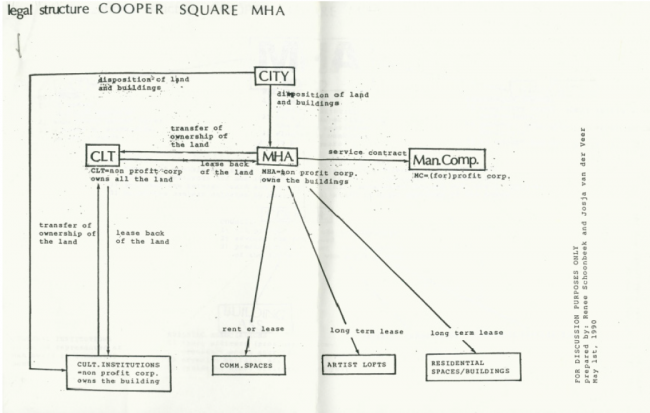
Courtesy of the Cooper Square Committee
The Rehab in Action to Improve Neighborhoods (RAIN) CLT is located a little bit further east on the Lower East Side. RAIN began as a coalition of homesteading groups, funded by the Lower East Side Catholic Area Conference (LESCAC), which itself was supported by Catholic Charities. RAIN was one of a myriad of grassroots groups that addressed the incongruence of a large stock of vacant City-owned buildings and a large population of people in need of housing, through homesteading and squatting in the 1970s and 1980s.
Like the Cooper Square Committee, LESCAC was also aware that many buildings converted into limited-equity co-ops through a range of City programs — including the short-lived homesteading program and TIL — were losing their affordability. Howard Brandstein, who at the time was working for LESCAC and now heads the Sixth Street Community Center, wrote in a 1984 position paper that “the land trust is a means for neighborhood residents to withstand the challenge of market forces entering the Lower East Side by bridging the separation between ownership as an expression of self-interest, on the one hand, and community empowerment on the other.”
The RAIN CLT was rooted in a progressive understanding of the role of faith-based institutions as stewards in their community, a relationship with the Institute for Community Economics (ICE), and leftist politics. According to a 1986 ICE newsletter, RAIN’s organizers were motivated to translate “Gospel into action.” Brandstein views CLTs as a “synthesis of anarchist and socialist thought.” CLTs incorporate the anarchist perspective on self-help and mutual aid with one of the philosophies behind European social housing and American public housing, which holds the ownership of affordable housing for the greater public good.
Brandstein believes that the RAIN CLT ended up being “too weak in the community domain.” The homesteading effort itself — claiming ownership of and rehabilitating buildings that were in legal limbo and deep physical distress — was monumental. The group did not have the capacity to create a fully developed CLT at the same time. Out of the fifteen buildings homesteaded by RAIN, nine joined the CLT. Getting buy-in from homesteaders, who did not want to give up their autonomy, was difficult. RAIN granted homesteaders the controlling stake on the board, which is an uncommon set-up for the landowning entity of CLTs. The RAIN CLT still exists today, and has preserved the affordability of the nine cooperatives on its land. However, each building functions as an independent cooperative, without the cohesion that is present at Sawmill or Cooper Square.
CLTs in NYC today
In the past few years, interest in CLTs has spiked, promoted by housing and urban policy organizations like the National Housing Institute, the Lincoln Institute, and the Cornerstone Partnership, large philanthropy groups like the Ford Foundation and the MacArthur Foundation, CLT-focused groups like the CLT Network and Burlington Associates, as well as the Federal Reserve. The CLT model’s flexibility and adaptability to local conditions make it an appealing solution to a range of problems affecting communities across the country including disinvestment, gentrification and displacement, foreclosure, loss of affordability due to expiring public subsidy, housing discrimination, and decreasing social capital.
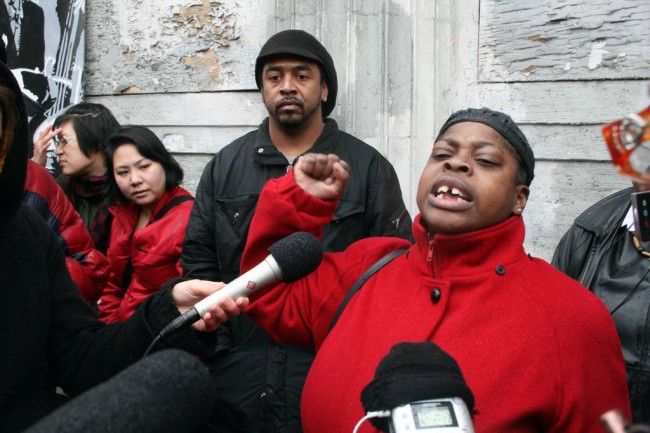
Picture the Homeless demonstration
In New York City, Picture the Homeless (PTH) — an organization founded and led by homeless and formerly homeless New Yorkers — identified the CLT model as a potential tool for addressing the severe shortage of permanently affordable housing that is within reach of extremely low-income people. Like activists on the Lower East Side in the 1980s, PTH wanted to highlight the disconnect between the city’s vacant property and skyrocketing population of under-housed, homeless, and doubled-up New Yorkers. In 2011, PTH counted vacant lots and buildings in one third of the city’s community boards. According to Arvernetta Henry, a member of PTH, “after the vacancy count, we started talking about CLTs. We took a tour of Cooper Square and saw how the model can benefit people in the shelter system.”
The New York City Community Land Initiative (NYCCLI) grew out of several parallel efforts. Representatives of Picture the Homeless, along with the New Economy Project, Community Board 11 (East Harlem), and the Housing Environments Research Group (HERG) at the CUNY Graduate Center convened at the Ford Foundation in 2012 to identify ways to promote the CLT model in New York City. Hillary Caldwell, a researcher actively involved with NYCCLI, would like to see the group “lay the groundwork for a grassroots city-wide alliance, which will develop infrastructure for community-driven neighborhood planning.”
NYCCLI has four working groups: education and outreach, which is facilitating discourse about the CLT model in the city; policy and legislation, which is defining a CLT legislative and policy agenda; governance, which is developing the governing structure framework for equitable and sustainable CLTs; and a pilot project group, which is actively working on starting a CLT in East Harlem.
For Picture the Homeless, East Harlem seemed like a natural place for establishing a CLT, because the neighborhood “has a lot of buildings with expiring subsidies and gentrification pressure,” according to Althea Yorke, another member of PTH active in NYCCLI. There is interest in the CLT model from Community Board 11, which recently co-produced a report with the Regional Plan Association that brought attention to the fact that one third of the neighborhood’s affordable housing stock — which includes rent-stabilized, public, Mitchell-Lama, and HUD-supported housing — is set to expire by 2040. The report recommended CLTs as a potential strategy for preserving affordable units.
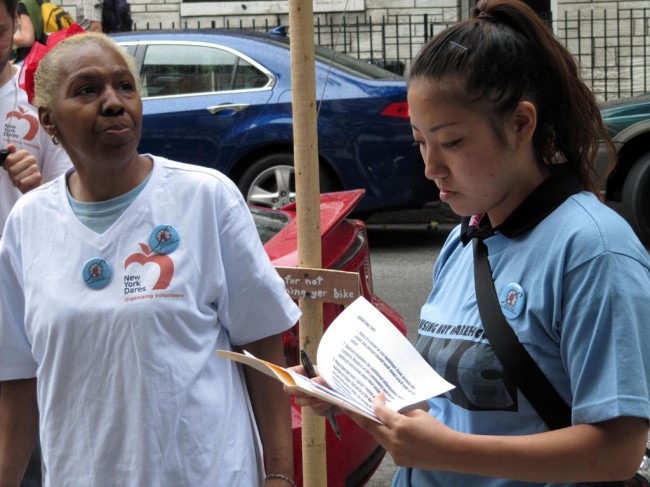
City-wide building vacancy count | courtesy of Picture the Homeless
The East Harlem pilot project aims to bring City-owned properties, distressed low-income co-ops preserved through the TIL and ANCP programs, and buildings still working through the TIL program into the newly created CLT. The properties identified by NYCCLI for the pilot have a concrete reason for joining the CLT, which will provide financial relief and stability of tenure. In the 1970s, when the Cooper Square CLT and RAIN took shape, New York was awash in City-owned, tax-foreclosed property. Today, that is no longer the case. However, East Harlem still has a significant number of City-owned properties, due to municipal programs that addressed the problem of landlord abandonment.
Broader application of the CLT model
The problem of affordability loss due to expiring subsidies compounded by mounting gentrification pressure is not limited to East Harlem. Most subsidized housing constructed by private developers — including Mitchell-Lama, HUD-assisted, and tax credit properties — are affordable only for a set period of time, usually 20 years. The city experienced a wave of opt-outs during the height of the housing bubble, which has since subsided. However, “as long as the city retains a growing economy, the real estate market will exert a strong pressure toward rising private rents and the removal of subsidized housing from the at-risk affordable stock,” according to a report by the Community Service Society.
A diversion of even a portion of subsidized properties into a CLT would go a long way towards preserving the city’s highly vulnerable affordable housing stock in perpetuity. Further, it would conserve the tax dollars that were spent on the construction and operation of these developments. The difficulty comes from finding a way to incentivize private landowners — whether they are limited-equity cooperative shareholders of a Mitchell-Lama, a for-profit developer who owns a HUD-assisted rental property, or a community development corporation that operates a building built with low-income housing tax credits — to join a CLT, and give up control over the disposition of land under their properties.
CLTs become more palatable when they offer the landowners or co-op shareholders something in return for transferring control over the land to the broader community (however it may be defined), beyond the knowledge that their property will serve as a resource to future generations of low- and moderate-income New Yorkers.
Today New York City has a sizable stock of privately owned, multi-family rental buildings in extreme physical distress and facing looming foreclosure. At the height of the housing bubble, some investors used the availability of cheap credit to overleverage these buildings, with disastrous consequences for their tenants. While the problem of predatory equity is fairly unique to overheated housing markets in rapidly gentrifying cities like New York, the national foreclosure crisis affecting single-family homes had a severe effect on neighborhoods with high rates of African-American homeownership, like St. Albans, Hollis, and Queens Village in southeast Queens. The CLT model could help single-family homeowners and tenants in multi-family buildings facing foreclosure stay in their homes, and in the process create units affordable in perpetuity.
Land acquisition is the key challenge for CLTs everywhere. According to Emily Thaden of the CLT Network, most CLTs use federal HUD funding to purchase land. Some have collaborative municipalities which funnel City- or State-owned land to CLTs, while others receive private land grants. In New York City, the factor that contributes to the extreme need for permanently affordable housing — the exorbitant cost of land — is what makes the creation of CLTs especially difficult.
Existing de Blasio administration ideas can mesh well with the CLT model. The transfer of City- or State-owned land to a CLT is generally the cheapest and easiest option. Cooper Square’s, RAIN’s, and NYCCLI’s East Harlem CLT’s future properties are all formerly city-owned. High real estate costs and changes to the city’s tax policy in 1996 have decreased the number of buildings and lots the city controls. During their 2011 vacancy count, Picture the Homeless found 3,551 vacant buildings and 2,489 vacant lots in the 20 Community Boards they surveyed, which is a significant number. However, only 10% of that property was City-owned. Of course, as Powell put it, “the lesson going forward is that the City should bank some of this land for community resources, as part of a city-wide CLT. That way, when communities step forward with a plan for their own salvation, as Cooper Square did, the cost of land doesn’t hold them back.”
Future CLT projects in New York will have to look beyond City-owned properties, both because the City-owned property pool has shrunk significantly, and because our current housing crisis is rooted in an aggressive real estate market, rather than disinvestment. In order to take the CLT model to scale in New York City, the current administration would have to make a significant financial and political commitment to the idea. The administration’s involvement is necessary for any group that may want to unravel the complex debt burdens carried by rental buildings affected by predatory equity or find a way to transfer privately held land into a CLT.
It is unclear if CLTs will play any role in the administration’s plan for the construction and preservation of 200,000 affordable units, which is set to be announced on May 1st. Some of the programs that have been floated by Mayor de Blasio mesh well with the CLT model, including mandatory inclusionary zoning and higher taxes on warehoused private vacant land.
While the administration has not shown any inclinations toward a city-wide or multi-neighborhood CLT yet, cities as different as Chicago, Austin, Las Vegas, and Chaska, MN, have created their own CLTs, as highlighted in a 2007 article in Shelterforce. Municipalities are increasingly initiating CLTs at a larger scale, usually as a means for preserving public subsidy and public land long-term across a range of neighborhoods. Some municipally initiated CLTs have governance structures that are different from community-initiated ones. The Chicago CLT’s board is appointed by the Mayor, for example. A CLT’s governance structure will reflect whether its main goal is to address the problem of expiring affordability or the issue of community control of its housing.
A commitment to the CLT model by the current administration would address many issues stressed by Mayor de Blasio during his campaign, including civic involvement, gentrification, and long-term housing affordability. The model, if applied in tandem with a range of other policies, could be a step towards addressing New York City’s growing crisis of inequality, by stabilizing the cost of land and “decommodifying property,” as Caldwell puts it. The heightened interest in CLTs from organizations as diverse as Picture the Homeless, the Ford Foundation, and the Federal Reserve may open new opportunities for the model’s application. NYC’s future CLT projects are likely to be very different from those that have been undertaken in the past, because the city has changed so much in the last 40 years. Two vital facets of CLT sustainability that should be cultivated within any future endeavor are active community participation, as well as a strong stewardship framework that will maintain the CLT well into the future.
The views expressed here are those of the authors only and do not reflect the position of The Architectural League of New York.
Comments